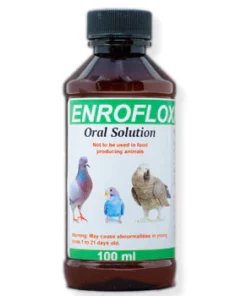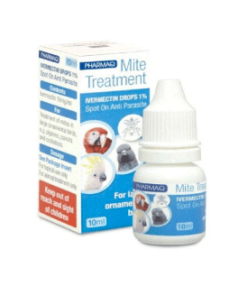enrofloxacin for rats
299,00 €
Learn about enrofloxacin for rats—its benefits, uses, and tips for effective administration. Find out how it combats infections and promotes health.
Enrofloxacin for Rats
Enrofloxacin, known by the brand name Baytril, is a commonly prescribed antibiotic for rats and other small animals. It belongs to a class of antibiotics known as fluoroquinolones and is valued for its broad-spectrum activity against various bacterial infections. Pet rat owners often turn to enrofloxacin when their rats face respiratory infections, abscesses, or other bacterial conditions. This article provides an overview of enrofloxacin’s uses, benefits, side effects, and important considerations when using it for rats.
Why is Enrofloxacin Prescribed for Rats?
Rats are prone to respiratory infections, abscesses, and other bacterial issues that can significantly impact their health. Enrofloxacin is particularly effective because it combats a wide range of bacteria, including gram-negative and gram-positive bacteria. It’s especially valuable for respiratory infections, which are common in pet rats and can become chronic without effective treatment.
Common Conditions Treated with Enrofloxacin
- Respiratory Infections: Mycoplasma and other bacterial respiratory infections are common in rats, often leading to symptoms like sneezing, wheezing, and labored breathing. Enrofloxacin is commonly prescribed as it can clear up infections and alleviate respiratory symptoms.
- Abscesses and Skin Infections: Rats are prone to abscesses, especially if they’ve sustained bites or scratches. Enrofloxacin helps to prevent or treat the bacterial infections that can result from such injuries.
- Urinary Tract Infections (UTIs): While less common in rats, UTIs can be treated effectively with enrofloxacin if bacteria are present in the urinary tract.
How Enrofloxacin Works in Rats
Enrofloxacin works by inhibiting bacterial DNA gyrase, an enzyme bacteria need to replicate. By blocking this enzyme, enrofloxacin prevents bacteria from growing and spreading, effectively stopping the infection. Its broad-spectrum nature means it can treat many types of bacteria, making it an excellent choice when the specific bacteria causing an infection isn’t known.
Dosage and Administration
The typical dosage of enrofloxacin for rats ranges from 5 to 15 mg per kg of body weight, usually administered once or twice daily. Dosages can vary depending on the severity of the infection, the rat’s health, and the veterinarian’s recommendations. Enrofloxacin is available in oral and injectable forms; the oral form is usually more practical for pet owners.
- Oral Solution: Usually mixed with a flavoring to mask the bitter taste, oral enrofloxacin is given through a dropper or syringe.
- Injectable Form: Sometimes used in cases where oral administration is difficult, or immediate, high-dose intervention is necessary.
It’s essential to follow the dosage instructions provided by a veterinarian closely. Missing doses or stopping treatment prematurely can result in the infection returning or worsening, as incomplete antibiotic courses may lead to resistance.
Benefits of Using Enrofloxacin for Rats
Enrofloxacin offers several benefits for treating bacterial infections in rats:
- Broad-Spectrum Efficacy: Effective against a wide range of bacteria, enrofloxacin treats multiple types of infections without needing a specific diagnosis.
- Minimal Side Effects: When given in the correct dosage, enrofloxacin is generally well-tolerated by rats and causes fewer side effects compared to other antibiotics.
- Widely Available: Enrofloxacin is a common antibiotic in veterinary medicine, making it easy to access through veterinarians or reputable online sources.
Possible Side Effects
While enrofloxacin is generally safe for rats, it may cause mild side effects in some cases. These can include:
- Gastrointestinal Upset: Some rats may experience mild stomach upset, resulting in decreased appetite or changes in stool.
- Neurological Symptoms: In rare cases, enrofloxacin may cause neurological effects, such as dizziness or imbalance, although this is uncommon in rats.
- Joint and Cartilage Development: Enrofloxacin can affect cartilage development, so it is typically avoided in young rats under the guidance of a veterinarian.
Most side effects are mild and resolve quickly after treatment is completed. However, if any side effects seem severe or persist, it’s best to consult a veterinarian.
Important Considerations
- Consult a Veterinarian: Enrofloxacin should only be administered under veterinary supervision, as incorrect dosages or improper use can lead to ineffective treatment or resistance.
- Monitor for Side Effects: Observe your rat for any unusual behaviors, changes in appetite, or other symptoms during treatment.
- Follow Full Treatment Course: Complete the full course of antibiotics as prescribed, even if symptoms appear to improve early on. Stopping treatment prematurely can lead to recurring infections.
Tips for Administering Enrofloxacin to Rats
Administering medicine to a rat can be challenging, especially since enrofloxacin has a bitter taste that rats dislike. Here are a few tips for easier administration:
- Use Flavored Syrups: Many veterinarians offer flavored versions of enrofloxacin, which can make it more palatable.
- Mix with Treats: Some rat owners mix the dose with a small amount of yogurt or other treats to mask the flavor.
- Follow with a Favorite Snack: Offering a treat immediately after giving the dose can help your rat associate the experience with something positive.
Conclusion
Enrofloxacin is a valuable and effective antibiotic for treating bacterial infections in rats. Its broad-spectrum action, combined with its minimal side effects, makes it a reliable choice for pet owners. However, proper dosage and veterinary guidance are essential to ensure your rat’s safety and health throughout treatment. If your rat shows symptoms of respiratory infection, abscesses, or other bacterial conditions, consult a veterinarian about whether enrofloxacin is the right choice.
Be the first to review “enrofloxacin for rats” Cancel reply
Related products
Rabbits, Guinea Pigs and Ferrets













Reviews
There are no reviews yet.